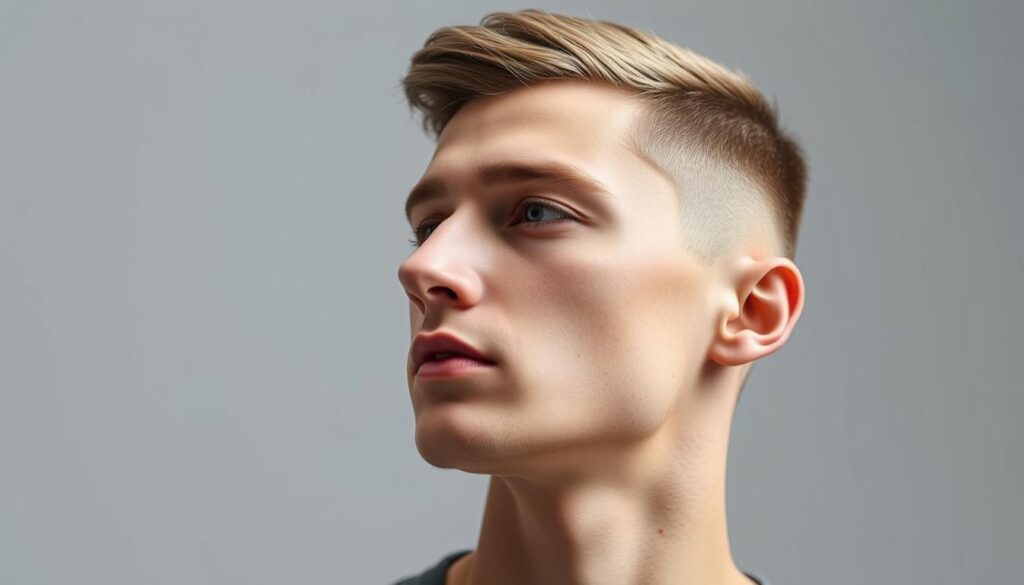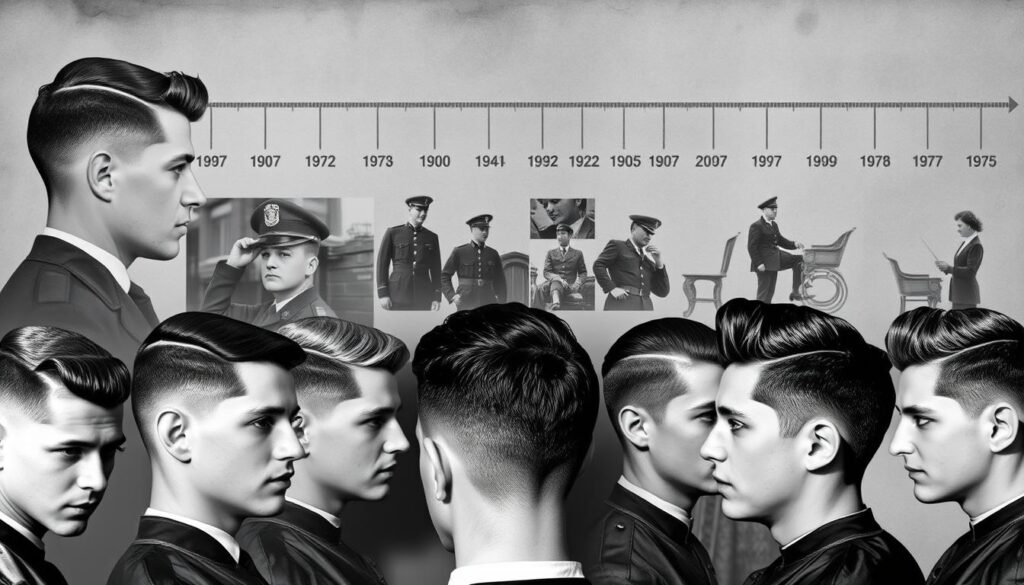
What if a hairstyle born in wartime trenches could become your modern style secret? The answer lies in a timeless choice that’s evolved for over a century – blending military precision with today’s fashion-forward edge.
Originally worn by soldiers for its practicality, this iconic look became a symbol of discipline. By the 1930s, rowing teams adapted it, adding subtle length for versatility. Today’s version keeps the clean, tapered sides but offers more freedom up top – perfect for men wanting structure without sacrificing personality.
You’ll find it works for nearly any face shape or hair type. The secret? Balancing shorter back/sides with 2-4 inches on top. This creates contrast that’s professional yet adaptable. Want texture for casual days? Use matte paste. Need sleekness for meetings? Try light-hold gel.
Key Takeaways
- Originated in early 1900s military culture, later adopted by athletes
- Modern versions balance traditional {{the}} sides with longer, styleable tops
- Works across hair types when properly tapered and proportioned
- Requires specific product choices based on desired finish (matte vs. shiny)
- Regular trims (every 3-4 weeks) maintain sharp lines
- Communicate clearly with barbers using photo examples
Understanding the Long Crew Cut

Modern hairstyles walk a tightrope between structure and self-expression. The updated take on a military classic gives you both – sharp edges where they matter and room to play with texture up top.
At its core, this style maintains shorter tapered sides while leaving 1.5-3 inches of length on the crown. This contrast creates visual interest without overwhelming your facial features. You get a clean outline that frames your face effectively.
The extra inches up top open doors for creativity. Use matte products for piecey texture during weekend outings or opt for light gel when meetings demand polish. Unlike buzz cuts, you’re not stuck with one-dimensional styling options.
Barbers often recommend this cut for its chameleon-like adaptability. Tousled morning bedhead transforms into office-ready sleekness in minutes. Evening events? Push strands sideways for subtle height that doesn’t scream “overdone.”
Maintenance stays simple with trims every 3-4 weeks. The balanced proportions mean growing phases look intentional, not messy. It’s the Goldilocks zone of men’s cuts – enough control to stay professional, enough freedom to showcase personality.
The History and Evolution of Crew Cuts

Military barracks and sports fields shaped this iconic hairstyle more than fashion runways. Soldiers in World War I first embraced short, tapered cuts to prevent lice and simplify helmet use. By World War II, it became standard for troops worldwide – a practical solution for harsh conditions.
Rowing teams at Ivy League colleges rebranded the look in the 1930s. Their version kept hair slightly longer on top for wind resistance during races. This athletic twist gave the style its name and made it popular beyond military circles.
Post-war America saw veterans keeping their cropped cuts as badges of honor. Hollywood stars like John Wayne and Paul Newman then transformed it into a symbol of rugged masculinity. By the 1950s, 1 in 3 American men sported some variation of the cut.
| Era | Key Development | Cultural Impact |
|---|---|---|
| 1910s | Military adoption | Practical battlefield solution |
| 1930s | Rowing teams’ adaptation | Collegiate athletic symbol |
| 1950s | Hollywood popularization | Mainstream masculine ideal |
| 2020s | Modern texture variations | Versatile professional look |
Today’s versions blend historical roots with contemporary styling. Barbering techniques now allow personalized fades and textured tops. What began as survival gear now serves as a style statement that bridges generations.
Essential Techniques for Styling a Long Crew Cut
Transform your morning routine into a styling session that lasts all day. The right approach combines strategic product use with precise shaping methods to maximize your look’s versatility.
Grooming Toolkit Essentials
Build your arsenal with three game-changers: a ceramic ionic dryer for heat protection, boar-bristle brush for direction control, and styling aids. Matte pastes add grit-free definition, while sea salt sprays create effortless texture. For polished occasions, water-based pomades offer shine without residue.
Daily Shaping Process
- Blot damp hair with microfiber towel (60% dry)
- Work nickel-sized product through palms
- Rake fingers upward through top section
- Blow-dry while combing hair forward at 45° angle
- Finish with cold shot to set memory
Adjust your technique based on hair density. Fine strands benefit from pre-styling mousse, while thick hair needs stronger hold products. “The front quarter-inch determines the whole look’s success,” says celebrity groomer Luis Ramos. “Always style this area first.”
Lock in your creation with flexible spray. Avoid crunchy finishes by misting from 12 inches away. For midday touch-ups, a pea-sized dab of wax reactivates with hand heat.
Choosing the Perfect Length for Your Crew Cut
Finding your ideal hairstyle balance starts with mastering proportions. The magic happens when you pair precise measurements with personal needs – creating a look that adapts to your daily life while keeping its sharp character.
Deciding on the Optimal Top Length
Your crown’s hair needs to hit the sweet spot: 1.5-3 inches. This range lets you spike, sweep, or tousle while maintaining structure. Thicker hair? Stay closer to 2 inches for easy control. Fine strands? Push toward 3 inches for added volume.
Consider your morning routine. Longer tops need 2-3 styling products for hold, while shorter lengths work with a single product. “Start at 2 inches if you’re new to this style,” suggests NYC barber Marco Tellez. “It gives room to adjust during your next trim.”
Balancing Short Sides with Longer Top
Create visual impact through contrast. Use these guidelines:
- #2 clipper (1/4″) sides for bold definition
- #3 guard (3/8″) for softer transitions
- Tapered neckline for seamless growth
The sides’ shortness determines how dramatic your top appears. Athletic builds can handle tighter fades, while round faces benefit from gradual tapers. Remember – your stylist can blend lengths differently around ears and temples for custom framing.
Maintain your look with 4-week trims. This keeps the top from overwhelming the sides and preserves clean lines. For growing-out phases, use matte clay to disguise uneven lengths while keeping texture intact.
Long Crew Cut: Mastering the Look
Achieving a polished yet adaptable appearance starts with understanding three core principles. The textured crown needs strategic shaping, while tapered sides maintain sharpness. This balance lets you switch between boardroom-ready and weekend-chic in seconds.
Your styling approach determines the final effect. For office days, work a dime-sized amount of matte pomade through damp strands. Brush forward for clean lines that showcase facial structure. Casual outings call for finger-combed texture – twist sections vertically to amplify natural movement.
| Technique | Tool | Effect |
|---|---|---|
| Brushing Forward | Fine-tooth comb | Professional finish |
| Side Sweep | Boar bristle brush | Modern asymmetry |
| Textured Tousle | Fingertips | Casual dimension |
| Natural Flow | Sea salt spray | Effortless hold |
Adapt to your hair’s unique patterns. Have a cowlick at the crown? Train it sideways during blowouts. Thick waves? Use thinning shears on the top layer for better manageability. “The best styles work with your biology, not against it,” notes groomer Alicia Monroe.
Maintain your masterpiece with weekly trims on the sides. Let the top grow to 2.5 inches before reshaping. This rhythm keeps proportions intact while allowing creative experimentation. Remember – true mastery shows when your look appears effortlessly perfect, not overly styled.
Styling Tips and Product Recommendations
Your styling success hinges on choosing tools that enhance rather than overpower your hair’s natural character. The right products act like invisible helpers – they shape without stiffness, define without crunch, and adapt to your daily needs.
Texturizing Sprays vs. Pomades
Sea salt sprays create beachy texture with a matte finish – ideal for casual looks requiring movement. Work a spritz through damp strands before blow-drying to amplify volume. Pomades offer slicker control, perfect for sharp side parts or polished business meetings. Celebrity stylist Jamal Carter notes: “Texturizers are your weekend warriors, while pomades handle formal heavy lifting.”
Best Practices for Natural Hold
Start with dime-sized amounts – you can always add more. Rub products between palms until warm, then rake through hair from roots outward. For all-day hold without stiffness:
- Blot hair with towel until 80% dry first
- Apply mousse at roots for lift
- Finish with light-hold spray 12″ away
Thick hair? Use clay-based formulas that grip without greasiness. Fine strands thrive with water-based gels that add body. Remember – texture comes from layering products smartly, not piling them on.
Celebrity Inspirations and Trending Crew Cut Styles
Hollywood’s elite prove versatility meets edge in today’s grooming trends. Chris Hemsworth sports a textured version with natural movement, while David Beckham elevates the classic fade with subtle asymmetry. These stars demonstrate how to balance military precision with modern flair.
- Low-fade texture (Timothée Chalamet’s tousled crown)
- Comb-over hybrid (Michael B. Jordan’s polished sweep)
- Sun-kissed dimension (Zac Efron’s caramel highlights)
Pro athletes like Patrick Mahomes show how to adapt the look for active lifestyles. His barber uses thinning shears on thick waves, creating manageable texture that withstands helmet wear. “The magic happens when we customize the taper,” says LA stylist Gina Rivera. “Celebrity hairstyles always have hidden details.”
Notice how stars switch up their styling for events:
- Matte paste for gallery openings
- High-shine pomade at award shows
- Sea salt spray during casual outings
Bring these ideas to your barber with photo examples. Ask for a #2 guard fade blended into 2.5 inches up top – the sweet spot for most men. This foundation lets you recreate red-carpet-worthy cuts without daily salon visits.
Modern Twists on the Classic Crew Cut
The classic crew cut gets a 21st-century makeover through innovative fades and structural detailing. Today’s versions blend military-inspired foundations with urban edge, offering tailored options for every lifestyle.
Embracing Fades and Comb Over Styles
Fade techniques redefine contrast in modern cuts. A low fade near the neckline keeps things subtle, while temple-level high fades make bold statements. Mid fades strike balance – ideal for professional settings needing polished yet fresh looks.
Comb-over hybrids add refined structure. A defined side part creates clean asymmetry, elevating simplicity into boardroom-ready elegance. Pair this with tapered sides for sharpness that lasts all day.
Key fade variations to consider:
- High fade: Starts above ears for maximum contrast
- Skin fade: Blends to bare skin at the neckline
- Taper fade: Gradual transition suits conservative workplaces
These techniques work across hair types. Thick textures gain manageability, while fine strands appear fuller. Your stylist can customize placement based on face shape and personal style goals.
